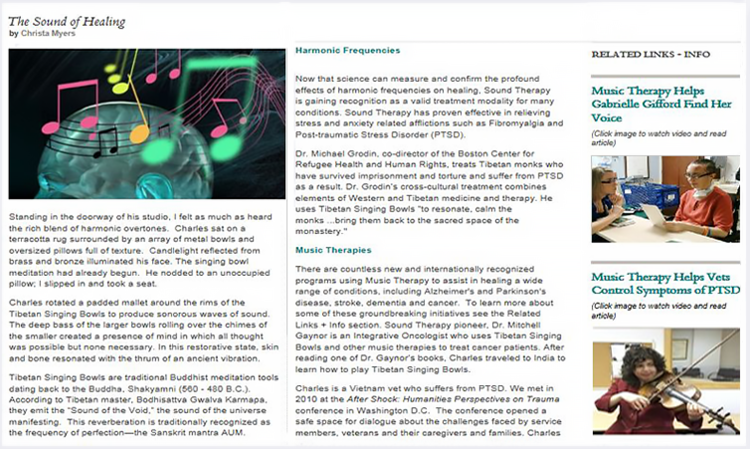
The Sound of Healing
Digital Content
Standing in the doorway of his studio, I felt as much as heard the rich blend of harmonic overtones. Charles sat on a terracotta rug, surrounded by metal bowls and people seated on oversized, textured pillows. Candlelight flickered off the brass and bronze surfaces, illuminating his serene face as he began the singing bowl meditation. He nodded toward an open cushion, and I stepped inside and took a seat.
With steady intention, Charles rotated a padded mallet around the rims of the Tibetan singing bowls, producing long, sonorous tones that filled the room. The deep bass vibrations of the larger bowls rolled beneath the soft, high tones of the smaller ones, creating a field of sound in which all thought was possible—but none necessary. In that still, expansive space, my skin and bones seemed to resonate with the thrum of an ancient vibration.
Sound Vibrations
Tibetan singing bowls are traditional Buddhist meditation tools dating back to the time of Shakyamuni Buddha (560–480 B.C.). According to Tibetan master Bodhisattva Gwalwa Karmapa, the bowls emit the “Sound of the Void,” the sound of the universe manifesting itself. This resonance is traditionally understood to embody the frequency of perfection: the Sanskrit mantra AUM.
Rhythmic tones like those from singing bowls can initiate healing through brainwave entrainment—the synchronization of the brain’s electrical patterns with external sound frequencies. Clinical studies using EEG mapping, blood analysis and other diagnostic tools have demonstrated that specific sound frequencies can produce positive physiological and neurological changes.
Harmonic Frequencies and Healing
Now that science can measure and confirm the profound effects of harmonic frequencies on healing, sound therapy is gaining recognition as a valid treatment modality for many conditions. It has proven effective in relieving stress and anxiety-related afflictions such as fibromyalgia and post-traumatic stress disorder (PTSD).
Dr. Michael Grodin, co-director of the Boston Center for Refugee Health and Human Rights, treats Tibetan monks who have survived imprisonment and torture, leaving them with PTSD. Dr. Grodin’s cross-cultural treatment combines elements of Western and Tibetan medicine and therapy. He uses Tibetan singing bowls “to resonate, calm the monks ... [and] bring them back to the sacred space of the monastery.”
The Expanding Role of Sound Therapy
There are countless internationally recognized programs using music therapy to aid healing for a wide range of conditions, including Alzheimer’s and Parkinson’s disease, stroke, dementia and cancer. Dr. Mitchell Gaynor, a pioneer in integrative oncology, incorporated Tibetan singing bowls and other sound therapies into his treatment of cancer patients, believing these practices helped support emotional balance and foster healing alongside conventional care.
Charles, the practitioner I encountered, was influenced by Gaynor’s work. Though I’ve since lost touch with him, he had developed a unique approach to sound meditation—one that left me feeling centered, grounded and in significantly less pain.
Everyone should experience the sound of healing at least once in their life.
Branded content from writing to visual design.
Written and designed to showcase EILEEN FISHER's Wellness Program and company culture, this piece is part of a series exploring health, psychology, and brain science.
- Pre-production: research, brand messaging, content alignment, strategic planning
- Production: writing, copywriting, content creation, graphic design, visual design
- Post-production: web page layout, content + visual alignment, SEO, user engagement
